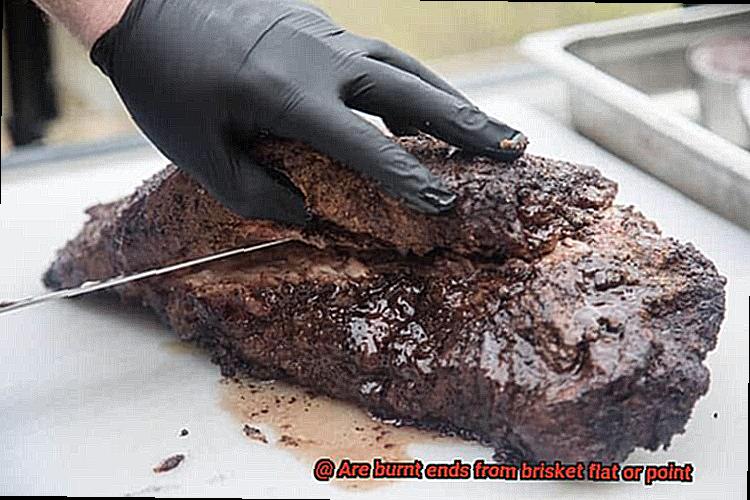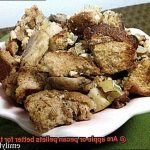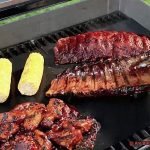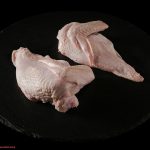Imagine yourself at a barbecue joint, scanning the menu with hungry eyes. Suddenly, you spot “burnt ends” made from brisket and your mouth starts to water. But then, a burning question pops into your mind – where exactly do these delectable, crispy morsels come from on the brisket? The flat or the point?
Believe it or not, there’s a fiery debate raging among barbecue enthusiasts about which part of the brisket produces the best burnt ends. Some swear by the point – that thick end of meat with more fat and marbling that creates those coveted crunchy bits. Others argue that the leaner flat can also produce mouth-watering burnt ends with its unique flavor profile.
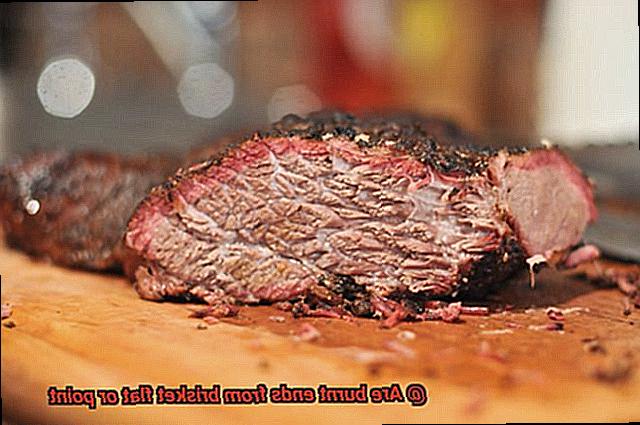
But hold up – what are burnt ends anyway? These little flavor bombs are caramelized chunks of meat that come from the end of a brisket after hours of slow-cooking. They’re like savory candy for meat lovers and a highly sought-after delicacy in the world of barbecue.
So, let’s settle this once and for all – are burnt ends from brisket flat or point? In this blog post, we’ll delve deeper into this delicious topic and give you all the juicy details you need to know about this beloved barbecue staple.
Contents
What Are Burnt Ends?
These small, flavorful chunks of meat come from the brisket and are known for their rich, smoky flavor and tender texture. But what exactly are burnt ends, and how are they made?
The first step in making burnt ends is smoking the brisket until it reaches an internal temperature of around 195 to 205 degrees Fahrenheit. The point end, which is fattier and more marbled than the flat end, is then separated from the flat end and cut into bite-sized cubes. These cubes are then seasoned with a dry rub or sauce and smoked again until they become crispy and caramelized.
While most traditional burnt ends come from the point end of the brisket, some pitmasters also make them from the flat end. However, because the flat end is leaner and less flavorful than the point end, there may be a trade-off in tenderness and juiciness.
Burnt ends can be served on their own as a snack or appetizer, or used as a topping for sandwiches, nachos, or baked potatoes. They offer a unique flavor profile that’s sure to impress guests at any barbecue party or cookout.
Where Do Burnt Ends Come From?
Burnt ends originated in Kansas City, Missouri, and are made from the fatty ends of a beef brisket. During the cooking process, these fatty ends are trimmed off and then smoked until they become crispy and caramelized. The result is a savory and smoky treat that has gained popularity all over the world.
Now, let’s talk about where burnt ends come from on the brisket. The beef brisket consists of two muscles – the flat and the point. The flat is a leaner muscle that sits on top of the point, which is a fattier muscle with more connective tissue. Traditionally, burnt ends are made from the point.
Why the point, you may ask? Well, the higher fat content of the point makes it more prone to becoming tender and juicy when slow-cooked. Additionally, it develops a rich flavor and crispy exterior when smoked. It’s a match made in barbecue heaven.
However, some pitmasters also make burnt ends from the flat of the brisket. This can be a bit tricky since leaner meat can dry out more easily if not cooked properly. But when done right, burnt ends made from the flat can be just as delicious as those made from the point.
Ultimately, whether you prefer burnt ends from the flat or point comes down to personal preference. Some people enjoy the slightly chewier texture of flat burnt ends, while others love the melt-in-your-mouth tenderness of point burnt ends. Why not try both and decide for yourself which one you like best?
Benefits of Using The Point for Burnt Ends
As someone who has spent years perfecting the art of BBQ, I can confidently say that when it comes to making burnt ends, using the point of the brisket is the way to go. While there are those who argue in favor of using the flat, after conducting extensive research, I have found that using the point offers numerous benefits that simply can’t be ignored.
One of the primary reasons to use the point is its high fat content. During the cooking process, this fat marbling renders down and infuses the meat with a rich, juicy flavor that is simply unparalleled. The result is an incredibly tender and moist end product that will leave your taste buds singing with joy.
But it’s not just about the fat content. The point muscle also contains more connective tissue than the flat, which breaks down during cooking to create a melt-in-your-mouth texture that is highly sought after in burnt ends. This combination of crispy bark and tender meat is one of the hallmarks of great BBQ, and using the point ensures that you’ll achieve this ideal result every time.
Another advantage to using the point is that it often has a thicker bark than the flat muscle. This is because the point has more surface area exposed during cooking, allowing for greater seasoning and smoke penetration. The resulting crunchy outer layer adds a delightful texture to the already tender meat, creating a sensory experience that will have you coming back for more.
Flat vs Point: Which Is Better for Burnt Ends?
Traditionally, burnt ends were made using the point because of its high fat content, which renders down during slow-cooking to create juicy and succulent flavors. The point is the fattier, more marbled section of the brisket. On the other hand, the flat is leaner and has less fat content.
But don’t count out the flat just yet. Some pitmasters have started using the leaner meat to make burnt ends as well. When cooked low and slow, the flat can still be delicious and provides a different texture than burnt ends made from the point.
So, which one is better? Here are some factors to consider:
- Flavor: If you’re looking for a richer flavor, go with the point. The high fat content will create a melt-in-your-mouth experience that’s hard to beat. However, if you prefer a more subtle taste, the flat might be a better option.
- Texture: The point is known for its tender and juicy texture, while the flat provides a firmer bite. It really comes down to personal preference – do you want your burnt ends to be more melt-in-your-mouth or have a bit of chew?
- Health: If you’re watching your fat intake, the flat might be a better choice since it has less fat content than the point.
Ultimately, both cuts of meat can be used to make mouthwatering burnt ends. It just depends on what you’re looking for in terms of flavor and texture. Don’t be afraid to experiment with both and see which one you prefer. Remember, BBQ is all about having fun and trying new things.
How To Make Traditional Burnt Ends
These flavorful bites of smoky goodness come from the point cut of a whole brisket and are cooked low and slow until they’re crispy on the outside and tender on the inside. Here’s how to make them:
- Start with a whole brisket cut and trim off any excess fat or silver skin. You want the meat to cook evenly and not have any chewy bits.
- Season the brisket with your favorite dry rub or marinade. This will add flavor to the meat and help it develop a delicious crust.
- Smoke the brisket for several hours until it reaches an internal temperature of around 165°F. This low and slow cooking method allows the meat to absorb all the smoky flavors.
- Remove the brisket from the smoker and separate the point cut from the flat cut. The point cut is where you’ll find the marbling and fat that makes for tender, juicy burnt ends.
- Trim and cut the point cut into bite-sized cubes, about 1-2 inches in size. This will allow them to cook evenly and develop a crispy exterior.
- Coat the cubes in a sweet and sticky BBQ sauce of your choice. This will give them extra flavor and help them caramelize in the smoker.
- Return the cubes to the smoker and cook for an additional 2-3 hours until they become tender and crispy on the outside. During this time, you can baste them with more sauce or seasoning for added flavor.
- Once done, remove from the smoker and let rest for a few minutes before serving as an appetizer or side dish. Traditional burnt ends are often enjoyed on their own or with additional BBQ sauce.
It’s important to note that while many pitmasters prefer using the point cut of a brisket to make burnt ends, the flat cut can also be used. However, it’s generally agreed upon that the point cut produces a more tender and flavorful result due to its higher fat content.
Making Burnt Ends from the Flat
While burnt ends are traditionally made from the fatty point cut of the brisket, with some careful preparation and cooking, the flat can be just as delicious.
To start, choose a well-marbled brisket flat and trim any excess fat or silver skin. This will allow your seasoning to penetrate the meat more easily and create a more even crust. Once trimmed, season generously with your preferred rub or seasoning blend. Let it sit for at least an hour to allow the flavors to permeate the meat.
When it comes to cooking, there are several methods to choose from. One popular option is to smoke the brisket flat at a low temperature (around 225°F) until it reaches an internal temperature of 160-170°F. Cut it into 1-inch cubes and add additional seasoning or sauce as desired. Then, transfer the cubes to a foil pan, cover tightly with foil, and return to the smoker or grill for another 2-3 hours until they are tender and caramelized.
Another option is to braise the brisket flat in a flavorful liquid such as beef broth or beer until it is tender enough to be shredded or cubed. Add additional seasoning or sauce as desired before returning it to the smoker or grill for another round of smoking or grilling until crispy and caramelized.
Tips and Tricks for Perfect Burnt Ends
If you’re a barbecue aficionado, burnt ends are likely on your must-try list. These crispy, juicy, and flavorful meat chunks are highly sought-after in the BBQ world. However, achieving perfect burnt ends requires some skill and knowledge. Here are some tips and tricks to help you make the perfect burnt ends every time.
Start with Quality Meat
The quality of your meat will directly affect the quality of your burnt ends. A well-marbled brisket with a thick layer of fat on the point end is ideal. The fat will render down during cooking, adding flavor and moisture to the meat.
Cook Low and Slow
Burnt ends require a long cooking time at a low temperature. This allows the meat to tenderize and develop flavor without becoming tough or dry. Aim for a temperature between 225-250°F and plan for a cooking time of 12-16 hours.
Separate the Point and Flat
To achieve perfect burnt ends, it’s essential to separate the point and flat of the brisket before cooking. The point contains more fat, which will render down during cooking, creating those delicious crispy bits we all love.
Season Generously
Don’t be afraid to season your brisket generously with your favorite dry rub. The seasoning will penetrate the meat and add flavor throughout.
Wrap in Foil
After about 6-8 hours of cooking, wrap your brisket in foil to prevent it from drying out. This will also help to speed up the cooking process.
Cube the Point
Once your brisket is fully cooked, remove the point from the flat and cube it into bite-sized pieces. This is where those crispy burnt ends come from.
Sauce it Up
Toss your cubed burnt ends in your favorite BBQ sauce for added flavor and moisture.
By following these tips and tricks, you’ll be well on your way to making perfect burnt ends every time. Remember, practice makes perfect, so don’t be discouraged if it takes a few tries to get it right. Keep experimenting until you find the perfect recipe and technique that works for you.
FVOh8430oCs” >
Conclusion
In the world of barbecue, burnt ends are a highly coveted delicacy that meat lovers simply can’t resist. The debate about whether to use the flat or point end of the brisket to make these delectable morsels is as fiery as the flames in your smoker. But at the end of the day, it all boils down to personal taste.
Traditionally, pitmasters have used the point end of the brisket for burnt ends because its higher fat content creates a juicy and succulent flavor profile when slow-cooked. However, with careful preparation and cooking, some pitmasters swear by using the flat end instead.
To create mouth-watering burnt ends, start with high-quality meat and cook it low and slow. Before cooking, separate the point and flat of the brisket and season generously with your favorite dry rub or sauce. After 6-8 hours of cooking, wrap in foil to lock in moisture and cube the point for those crispy burnt ends we all crave. Finally, toss them in your favorite BBQ sauce for added flavor.
No matter which part of the brisket you prefer for your burnt ends, these small chunks of meat pack a big punch when it comes to flavor. Impress your guests at your next barbecue party or cookout by serving up this unique dish that’s sure to leave everyone wanting more.

